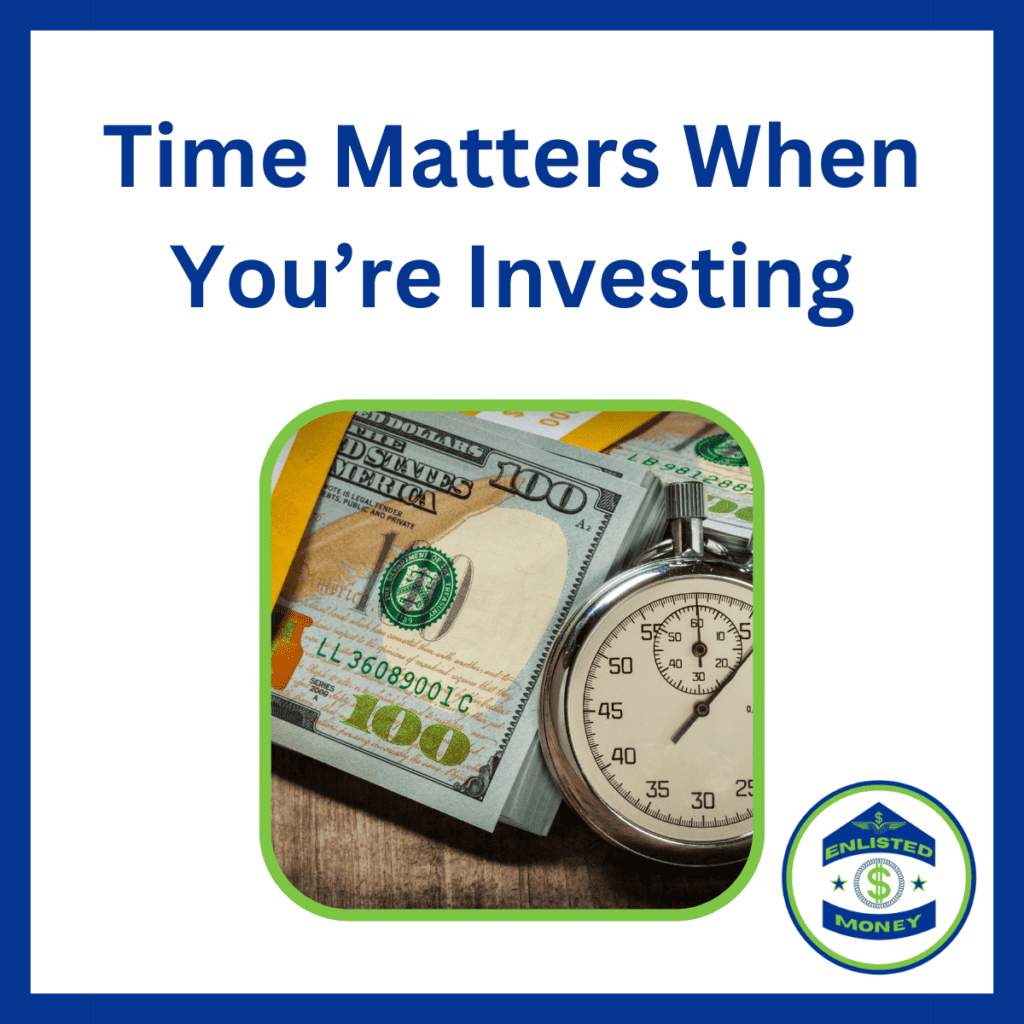
There’s so many different things we could focus on when it comes to investing, but time matters. It’s often overlooked too. In financial planning, we talk a lot about “time-horizon” and the time value of money (TVM) calculations we do.
Bottom line: when you choose to invest your money in one place, you’re saying no to investing money elsewhere.
Also, each decision carries its own level of risk. If you can’t afford to wait for an investment to [possibly] recover, then you might need to invest it a little differently than something you don’t need for 30 years. In other words, you wouldn’t put your vehicle fund you need to use next month the same place you’d put your money to live on when you retire.
Short-term vs Intermediate vs Long-term Investments
One of the biggest things to consider is when you’ll need the money back. For me, I like to think about three different timeframes or “investment zones” to consider:
- Short-term = Less Than 1 Year
- Intermediate = 1-5 Years
- Long-term = 5+ Years
Short-term Investments
If I need to use the money within 1 year, I pretty much stick to high-yield savings accounts. I just need this money in this investment zone to be there, ready when I need it. If I invested the money in anything with the potential to drop in value like stocks, I might lose money if I need to use the money right away.
Also, the interest earned within a year is much less relevant compared to the interest or growth which might occur over a longer period of time. Our savings account for big annual expenses is in a high-yield savings account. We’ll pull from it as we need it throughout the year. We pay for things like our Amazon Prime membership, contact lenses, and back-to-school clothing from this fund.
Intermediate Investments
I treat money I’ll need within the next 1-5 years much the same as my short-term money but start to shift things a bit. I’ll use high yield savings accounts here too, but I also start thinking about investing some of this money.
For instance, we recently replaced my wife’s van with a newer Jeep. All our money in our vehicle fund was in cash ready to go. We won’t need to buy again for a while, so we’ll start investing our vehicle funds savings into a broad index fund portfolio inside our taxable brokerage account. I’ll keep putting some money into the high-yield savings account for regular vehicle expenses like oil changes, wiper blades, etc.
Retirement Transition Fund
Another example of an intermediate zone investment is my “transition fund” for when I retire from the Army. My goal was to have six months’ worth of expenses (minus my estimated pension) ready just in case. I started this almost four years from when I want to retire, so I invested this money to let it grow.
I’m okay if I can’t use this money if the market happens to be down. This is more of a self-made insurance policy than anything. I hope I don’t need it, but if I do, it’ll be there. We still have our emergency fund on top of this.
I use a taxable brokerage account for this because I’ll be pulling the money out over a year later and will be getting long-term capital gains rates. For our level of income, this will get taxed at the 15% long-term capital gains rate (2023).
Note: Some folks may say “use an ETF for better tax efficiency.” For us, our income is low enough that the dividends and/or short-term capital gains would actually be taxed at a lower ordinary income rate of 12%, so ETFs don’t actually help me out. It’s better for us to get dividends taxed at the lower rate, reinvest that money, and let it ride. However, this is a small difference, so I probably wouldn’t even worry about it.
Long-term Investments
For long-term investing, I use broadly diversified index funds in either a taxable or tax-advantaged account. This money can stay invested long-term, so ups and downs in the stock market aren’t going to be a major deal.
Retirement Accounts
For us, all our investments for retirement are in Roth accounts. Roth Thrift Savings Accounts and Roth IRAs have several advantages – especially for enlisted service members. The majority of our retirement savings are in my Roth TSP.
However, I started a Roth IRA many years ago and will use that more in the future. My wife also has a TSP from when she worked at the commissary and a Roth IRA. This money is for us to use many years down the road (or when we retire early).
I wish we’d started investing for this sooner, but we always had other things we wanted to spend money on like a new truck many years ago.
Taxable Brokerage Account
We’ll also save additional money in taxable brokerage accounts later on, but right now, the real focus for us is getting ready to retire from the Army. If we don’t end up needing my “transition fund” then I’ll leave that money invested as a “just because” fund of some sort.
Taxes Matter
Another thing to consider is the taxes. Depending on what you’re using the money for and when you want to use it, there may be some tax savings for you. No matter what, you need to know the rules.
Ordinary Income
Your ordinary income is taxed at a certain rate based on how much you make in the year. This gets a little confusing because you have to guess what you’ll owe as you go, then figure it all out after the fact when you file. However, you can get a pretty good guess by your monthly taxable income.
I’m not going to get into the specifics of exactly how to calculate your tax bill. This is mainly because it’s impossible to do that without literally filing your taxes. Also, it’s not critical to this discussion. For a quick lesson on how tax brackets work, you can check out my podcast episode where I touch on this below.
Capital Gains
Capital gains are basically just when you buy something at one price and then sell it for a profit. This can be stocks, commodities (gold), or other “stuff” (cryptocurrency, real estate, etc.). If you held the property for 365 days or less, it’s taxed at the short-term capital gains rate which is your ordinary income brackets. In other words, it’s just lumped in as regular income.
If you hold the property for more than 365 days, your gains will be treated as long-term capital gains. These are taxed at a different rate which is based on your income level. The long-term capital gains rates are 0%, 15%, 20%, 25%, and 28% as of 2023.
Why Taxes Matter to Your Investments
If you don’t know the rules surrounding how your investments are taxed, you can’t really know if you’re doing the right thing. Knowing the rules might save you thousands or possibly millions of dollars over your lifetime.
If you don’t know the rules, you could end up screwing yourself over. If you get a great return on an investment, but you get taxed at a higher rate than necessary, your actual usable income is much lower. That’s what really matters – the money you actually get to keep and use.
Investing in a Mix as Needed
To wrap things up, I just wanted to highlight that you can, and should, use different account types for different things. Just because you can invest the money, doesn’t mean you should. There’s no sense in putting your money at risk just to earn a few dollars. On the other hand, if you’ve got your TSP invested in the G Fund (not really earning anything), you’re losing out on a great opportunity to let your money grow. Every dollar your money earns for you is one less dollar you need to earn elsewhere.
